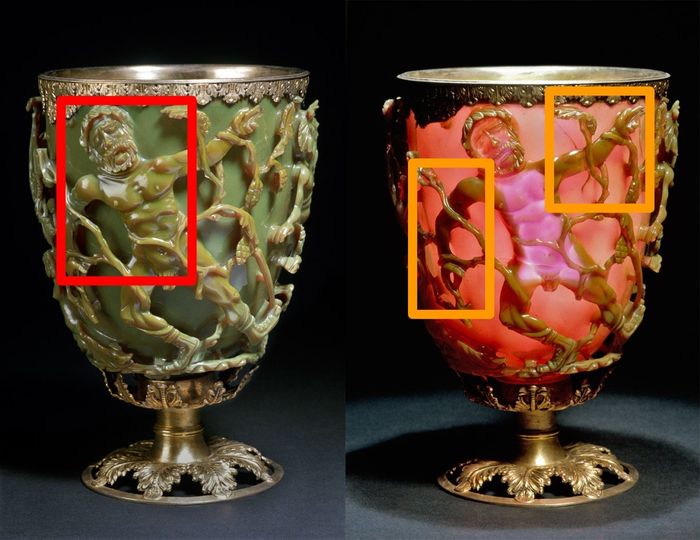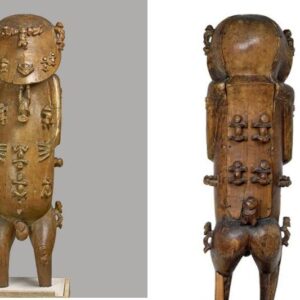The Lycurgus Cup is an enigmatic and extraordinary artifact from the end of the Roman period, dating back to the 4th century AD. This ancient drinking vessel, made of glass, is renowned for its striking colors and intricate design. The cup’s appearance changes dramatically depending on the lighting: it appears green when lit from the front and red when lit from behind. This phenomenon is due to the presence of colloidal gold and silver particles within the glass, showcasing the advanced technological and artistic capabilities of its creators.

The Lycurgus Cup
Late Roman Empire, AD 300s
This cage-cup is incredibly rare. Its glass contains tiny amounts of gold and silver which cause it to turn from opaque green to translucent red when light is shone through. It may have been part of a wealthy Roman’s banqueting set, making its imagery of Dionysus, Greek god of wine, highly appropriate. Its green and red qualities may even have been intended to evoke white and red wine. Alternatively, it may have been used as a lamp because the gilded silver rim and foot were probably added in the late 1700s.
Formerty in the collection of Lord Rothschild,
purchased with the sid of the An Fund, 1958,12021
The Lycurgus Cup is a prime example of a “cage cup,” a type of vessel where the primary glass cup is encircled by an intricate, decorative cage-like pattern. This external cage is not just a mere ornamentation but also a storytelling medium. The design of the cage on the Lycurgus Cup depicts scenes related to the mythological story of King Lycurgus of Thrace, known for his tragic and violent downfall.
King Lycurgus, a figure from Greek mythology, is famously known for his opposition to the cult of Dionysus, the god of wine and revelry. In a fit of anger and madness induced by Dionysus, Lycurgus attempts to destroy the god’s followers and the sacred vines. As punishment, Lycurgus meets a gruesome end, often depicted as being entangled and torn apart by vines. The cup captures this dramatic narrative, illustrating various scenes of Lycurgus’s anger and ultimate demise.
The Lycurgus Cup’s artistic craftsmanship extends beyond the storytelling imagery. The rim of the cup is mounted with a silver-gilt band adorned with leaf ornaments, adding a touch of opulence and further emphasizing the cup’s luxurious nature. Additionally, the foot of the cup features an open-work design of vine leaves, a motif that reinforces the connection to the story of Dionysus and the fate of Lycurgus.
This remarkable cup not only serves as a drinking vessel but also as a symbol of the technological and artistic prowess of the late Roman period. The use of dichroic glass, which changes color based on lighting conditions, demonstrates a sophisticated understanding of materials and their properties. This technology, combined with the elaborate storytelling through relief imagery, makes the Lycurgus Cup a masterpiece of ancient art.
The Lycurgus Cup remains one of the most studied and admired artifacts from antiquity. Its mysterious optical properties and the rich narrative depicted in its design continue to fascinate historians, archaeologists, and art enthusiasts. The cup is a testament to the ingenuity and creativity of ancient artisans, encapsulating a blend of mythological storytelling, advanced technology, and exquisite craftsmanship.
In conclusion, the Lycurgus Cup is a fascinating and mysterious antique from the 4th century AD. This glass drinking vessel, characterized by its green and red hues, intricately depicts scenes representing the death of King Lycurgus of Thrace. The cup’s rim is mounted with a silver-gilt band of leaf ornaments, and its foot is adorned with open-work vine leaves. As a “cage cup,” it exemplifies the high level of artistic and technological achievement in the late Roman period. The Lycurgus Cup stands as a testament to the enduring legacy of ancient craftsmanship and the captivating stories of mythology.
News
The stunning Temple of Garni, Armenia. Built nearly 2,000 years ago.
Nestled amidst the rugged terrain of Armenia stands a testament to ancient splendor: the stunning Temple of Garni. Built nearly 2,000 years ago, this architectural marvel is…
Reviving the Ancient Abu Simbel Temples: Restoration Efforts in Aswan, Egypt, 1968
In 1968, an extraordinary feat of human endeavor unfolded on the banks of the Nile River in Aswan, Egypt. The ancient Abu Simbel temples, standing for over…
Rare and Ancient Sculpture of Lord Ganesha Carved into the Rocks at Raghunandan Hills (Unakoti)
Nestled amidst the rugged terrain of Raghunandan Hills lies a treasure trove of history and spirituality — the rare and ancient sculpture of Lord Ganesha, immortalized in…
African Architecture: The Unique Construction of Djenné’s Great Mosque
In the heart of Mali lies a testament to human ingenuity and cultural heritage: The Great Mosque of Djenné. Built with indigenous materials, primarily mud brick and…
Bronze Spartan Shield from the Battle of Sphacteria 425 BC Displayed at Athenian Agora Museum
Among the many treasures housed at the Athenian Agora Museum, one artifact stands out for its historical significance and the stories it holds: a bronze Spartan shield,…
Enigmatic Pacific Deity: Captivating Polynesian Artistry
In the heart of Polynesia, amidst the whispers of the Pacific winds and the rhythm of ancient chants, lies a testament to the spiritual and artistic richness…
End of content
No more pages to load











